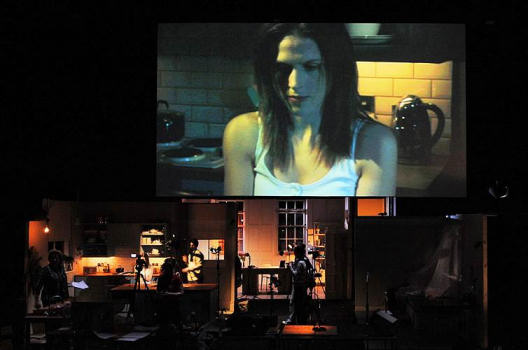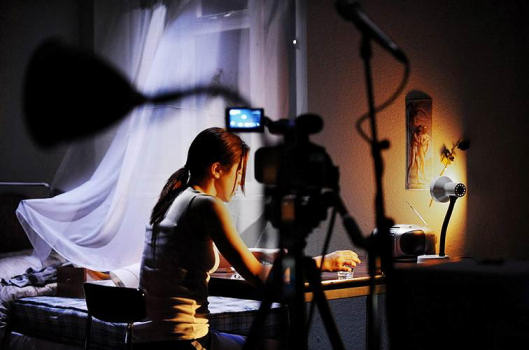Other Links
Editorial Board
-
Editor - Bill Kenny
-
Deputy Editor - Bob Briggs
Founder - Len Mullenger
Google Site Search
SEEN AND HEARD
UK OPERA REVIEW
Purcell/Katie Mitchell, After Dido:
Soloists, actors, members of the Orchestra of English National Opera, Christian
Curnyn (conductor).
Young
Vic Theatre, London, 16.4.2009 (MB)
It would be all too easy to fall into the trap of reviewing After Dido as
if it were a production of Dido and Aeneas. Such would be a mistake, not
least since any reservations one might voice could then be written off as a
consequence of having failed to understand the nature of the beast: an opera
critic at sea in the world of contemporary theatre. What, then, is After Dido?
It is described as ‘a live music and film performance inspired by Purcell’s
Dido and Aeneas’ and at its core, at least in one sense, stands a
performance of Purcell’s masterpiece: ‘Tristan und Isolde in a pint pot,’
as Raymond Leppard so memorably once described it. However, Dido and Aeneas
is not produced on stage; After Dido is. This tells, in the words of the
publicity material, ‘three contemporary urban stories of grief, lost love,
departure, and death,’ which unfold in self-contained locations on different
sections of the Young Vic stage. But After Dido is also to be found in
‘the making of’ these stories.
The ‘stories’ relate to loss of one sort or another, just as Dido itself
does, although there is none of the anticipation that characterises the opera’s
opening scene. The time scale could hardly have accommodated that, given that
the stories operate in ‘real time’. We witness a lonely girl, Helen (Amanda
Hale), in her bedsit, play with her derisory ‘meal’, wind blowing in and traffic
passing outside her window, as she moves towards her overdose. Henry (Dominic
Rowan) contemplates the breakdown of his relationship, made utterly apparent
when joined later on by Nell (Helena Lymbery). Clearly, the sooner a decisive
break is made the better. Most moving for me was Sandy McDade’s superlatively
well acted Anna, dealing in her kitchen – and outside in the garden, thanks to
typically virtuosic camera work – with a bereavement. At one time, we actually
see her dancing, both on stage and on screen, with whomever it is she has lost,
but her facial expressions, her trembling hands, her tears, are perhaps more
telling still.
Dido/Sorceress – Susan Bickley
Sailor/Stephen – Eyjólfur Eyjólfsson
Bass – James Gower
Adam Green – Aeneas
Helen (in the bedsit) – Amanda Hale
Second Witch/Jenny – Helen Jarmany
Nell (in the study) – Helena Lymbery
Dido’s Woman/Prologue soloist – Lina Markeby
Anna (in the kitchen) – Sandy McDade
Tenor – Eamonn Mulhall
Henry (in the study) – Dominic Rowan
First Witch – Madeleine Shaw
Katie Mitchell (director)
Vicki Mortimer (designer)
Leo Warner (director of photography)
Philip Gladwell (lighting designer)
Gareth Fry, Carolyn Downing (sound designers)
Pia Furtado (assistant director)
Helena Lymber (artistic associate)
Members of the Orchestra of English National Opera (Janice Graham, Matthew Ward
(violins), Amelie Roussel (viola), David Newby (violoncello), Reiko Ichise
(viola da gamba), David Miller (lute/baroque guitar Christian Curnyn
(harpsichord/conductor)

This ‘making of’ is not really a story in itself, after the manner of, say,
Ariadne auf Naxos, yet it acquires a dramatic thrust of its own, not least
since it is with these ‘workings’ that the piece opens, in the prologue –
Dido’s own Prologue is, of course missing – to a radio broadcast, in which
we hear recorded snatches of other items of Purcell’s theatre music. There were
times when I wondered whether viewing of the technicians, moving cameras, actors
other than the ‘principal’ actors performing the close up shots and sound
effects, and so on, was all a little too much to follow. That, however, may
partly have been the point, or at least one of the points, in that each viewer
therefore had to decide at any point whether to watch part of ‘the making of,’
the actor(s) on stage, the actor chosen at that moment for display on the screen
above the stage, or the musicians – or indeed, to flit between them, or to try
to watch more than one aspect at once. To witness, for instance, one of the
ensemble – I cannot now remember which it was – being filmed moving a light bulb
over a window, whilst seeing this cleverly projected as the passing of car
headlights in another ensemble member’s flashback, whilst also watching that
second member reacting to the ‘live’ broadcast of Dido and Aeneas upon
the three hundred and fiftieth year anniversary, without even considering the
possibility that one might be at least partly watching one of the other stage
events, presents multiple possibilities for the viewer, guided though he may be
by the decision concerning which aspect is being shown on film at that time. I
purposely use the word ensemble, since the boundaries between singers, actors,
and ‘stagehands’ are fluid. Susan Bickley, having a little break from singing
Dido and the Sorceress, is seen washing up at one point. This does not
seem gratuitous, since a true sense of theatrical ensemble is thereby achieved.
Sadly, this does not include the musical players; perhaps this would simply have
been too difficult to integrate, but it is a thought. The work of the entire
production team is throughout of an extremely high standard, Leo Warner of Fifty
Nine Productions Ltd, working again with Mitchell, as he did for her National
Theatre productions of Waves and Attempts on Her Life. Little is
said, only ‘BBC’
radio announcements and a few punctuating ‘readings’, but then it appears
nothing need be said. Perhaps we ordinarily rely too much upon the spoken word,
when music and visual stimulus can provide so much.

Helen - Amanda Hale
What of Dido itself? It would be remiss not to comment upon the musical
performance at all. A string quartet and continuo group, directed from the
harpsichord by Christian Curnyn, provide the ‘orchestra’. If there were times
when I should have preferred a fuller, warmer sound, what we heard was by the
same token rarely unduly abrasive, although it veered somewhat between different
styles of Purcell interpretation, the violins sometimes sounding more like old
‘fiddles’, sometimes more like members of a Classical quartet. I could not
always discern why this should be so, but it did not worry me unduly. Tempi were
generally on the brisk side but were not unyielding, which is more important.
Purcell’s dissonances have been more searing; there was plenty of dissonance on
stage, however.
Susan Bickley was excellent in her dual role. Everyone who knows Dido
will have a favourite artist or favoured artists in the title role; it is that
kind of piece. I for one can never forget Dame Janet Baker and also retain a
great fondness for Victoria de los Angeles. Bickley has her own ideas, proves
ever musical and ever attentive to the text, and certainly penetrates to the nub
of the drama, though I sometimes found her voice a little lacking in refulgence.
By the same token, however, one might wonder whether her Lament was unduly
undercut by the amplified ticking of an alarm clock; I know this is not a
production of the opera as such, but it seemed a pity. As the Sorceress, she did
not opt for the overt pantomime vocalisation of the unforgettable Monica
Sinclair (on the Baker/Antony Lewis recording), but there was a differentiation
of voice, a certain ‘old Englishness’ to the differentiated portrayal. Adam
Green’s Aeneas was sometimes less than ideally focussed, but the rest of the
musical ensemble was of a consistently high quality.
Part of the reason for ENO’s
collaboration with the Young Vic is to reach a different audience from that
which typically visits the Coliseum. This is definitely to be applauded and I
can imagine that the name of Katie Mitchell will do no harm in attracting
curious theatre goers, as opposed to opera fans. After Dido is an
intriguing piece, which is certainly to be preferred to a stale and vain attempt
at reconstruction. It is a pity that no one seems especially interested in a
more radical take upon Handel’s operas, in this shared anniversary year. Musical
virtues notwithstanding, their theatrical weaknesses are rather more glaring
than any in Purcell’s miniature, if incomplete, tragedy, so a rescue bid would
doubtless be appreciated by those of us without the coterie of the at least
slightly fanatical. Still, that problem is no fault of this production, which
may well prove one of the more notable contributions to the anniversary
celebrations.
Pictures © Stephen Cummiskey
Back
to Top
Cumulative Index Page
